原料耗用分析表
毛利分析表

餐饮毛利分析表(2010.0说明:1.本周自助餐收入为108761元(其中早餐29806元,二楼自助78955元),比上周增加32270元,增加69.12%;宴入为319540元,比上周增加193081元,增加152.68%;本周自助餐人均消费123.56元,宴会人均消费81.25元。
本月的自助319540元,比上月增加2619元,增加0.83%。
2.本周自助餐成本为56446元,比上周增加21648元,增加62.21%,(其中热菜区占13.17%,西餐区15.53%,日式11.52%);宴会成本为77106元,比上周增加45561元,增加144.43%;食品总成本为133552元,比上周增加67209元,增加食品总成本比上月14420元,增加8.4%。
3.本周自助餐毛利率为48.1%,较上周上升1个百分点,宴会毛利率为63.42%,较上周上升16个百分点,本周食品餐饮毛利分析表(2010.0餐饮毛利分析表(2010.02.本周自助餐成本为9455元,比上周减少46991元,减少83.25%,(其中热菜区占17.54%,西餐区3.65%,日式区15.73%);宴会成本为71105元,比上周减少6001元,减少7.78%;食品总成本为80559元,比上周减少52992元,减少39.6比上月增加41310元,增加38.64%。
食品总成本为214111元,比上月减少1457元,减少0.68%。
3.本周自助餐毛利率为40.43%,较上周下降8个百分点,宴会毛利率为77.21%,较上周上升14个百分点,本周食品百分点,宴会毛利率为71.65%,较上月上升18个百分点,总食品毛利率为66.92%,较上月上升15个百分点。
说明:1.本周自助餐收入为15870元(其中早餐12374元,二楼自助3496元),比上周减少92891元,减少85.41%;宴会327808元,比上周增加8268元,增加2.59%;本周自助餐人均消费116.53元,宴会人均消费47.42元。
电大《成本管理》形成性考核作业参考答案(1)
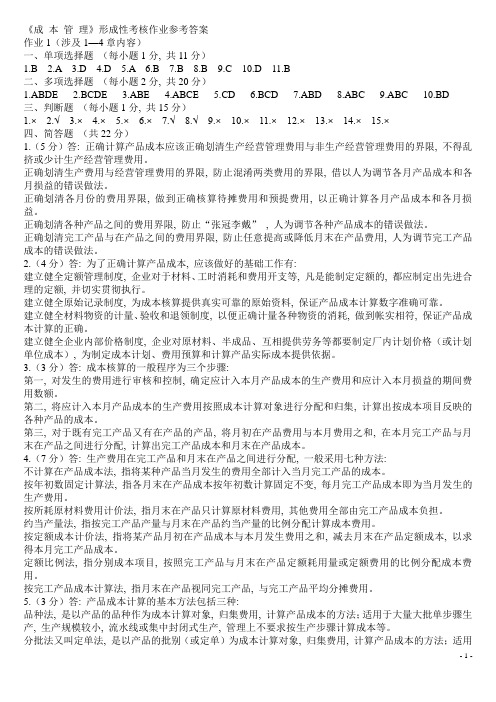
《成本管理》形成性考核作业参考答案作业1(涉及1—4章内容)一、单项选择题(每小题1分, 共11分)1.B2.A3.D4.D5.A6.B7.B8.B9.C 10.D 11.B二、多项选择题(每小题2分, 共20分)1.ABDE2.BCDE3.ABE4.ABCE5.CD6.BCD7.ABD8.ABC9.ABC 10.BD三、判断题(每小题1分, 共15分)1.×2.√3.×4.×5.×6.×7.√8.√9.× 10.× 11.× 12.× 13.× 14.× 15.×四、简答题(共22分)1.(5分)答: 正确计算产品成本应该正确划清生产经营管理费用与非生产经营管理费用的界限, 不得乱挤或少计生产经营管理费用。
正确划清生产费用与经营管理费用的界限, 防止混淆两类费用的界限, 借以人为调节各月产品成本和各月损益的错误做法。
正确划清各月份的费用界限, 做到正确核算待摊费用和预提费用, 以正确计算各月产品成本和各月损益。
正确划清各种产品之间的费用界限, 防止“张冠李戴”, 人为调节各种产品成本的错误做法。
正确划清完工产品与在产品之间的费用界限, 防止任意提高或降低月末在产品费用, 人为调节完工产品成本的错误做法。
2.(4分)答: 为了正确计算产品成本, 应该做好的基础工作有:建立健全定额管理制度, 企业对于材料、工时消耗和费用开支等, 凡是能制定定额的, 都应制定出先进合理的定额, 并切实贯彻执行。
建立健全原始记录制度, 为成本核算提供真实可靠的原始资料, 保证产品成本计算数字准确可靠。
建立健全材料物资的计量、验收和退领制度, 以便正确计量各种物资的消耗, 做到帐实相符, 保证产品成本计算的正确。
建立健全企业内部价格制度, 企业对原材料、半成品、互相提供劳务等都要制定厂内计划价格(或计划单位成本), 为制定成本计划、费用预算和计算产品实际成本提供依据。
合同耗用材料统计表模板
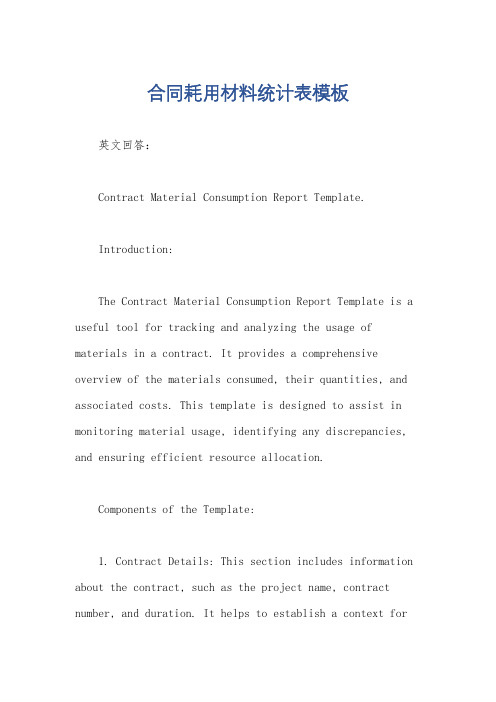
合同耗用材料统计表模板英文回答:Contract Material Consumption Report Template.Introduction:The Contract Material Consumption Report Template is a useful tool for tracking and analyzing the usage of materials in a contract. It provides a comprehensive overview of the materials consumed, their quantities, and associated costs. This template is designed to assist in monitoring material usage, identifying any discrepancies, and ensuring efficient resource allocation.Components of the Template:1. Contract Details: This section includes information about the contract, such as the project name, contract number, and duration. It helps to establish a context forthe material consumption analysis.2. Material List: This section lists all the materials used in the contract. Each material entry includes details such as the material name, description, unit of measure, and unit cost. This information is crucial for accurately calculating the total cost of each material used.3. Consumption Data: This section captures the consumption data for each material. It includes columns for recording the quantity used, the date of consumption, and the associated cost. This data can be entered on a regular basis to keep track of the ongoing material usage.4. Summary and Analysis: This section provides a summary of the material consumption data. It includes the total quantity consumed, the total cost incurred, and any variations from the estimated consumption. This analysis helps in identifying any over or underutilization of materials and enables better decision-making for future contracts.Benefits of Using the Template:1. Cost Control: By tracking material consumption and associated costs, the template helps in controlling expenses and avoiding budget overruns. It enables theproject manager to identify any excessive material usageand take corrective measures.2. Resource Optimization: The template allows for the analysis of material consumption patterns, therebyfacilitating better resource allocation. By identifying trends and patterns, the project team can optimize the procurement and utilization of materials, leading to improved efficiency.3. Transparency and Accountability: The template promotes transparency and accountability by providing aclear record of material consumption. It helps in ensuring that the materials are used as per the contractrequirements and that any deviations are promptly addressed.4. Decision-Making Support: The template providesvaluable insights into material consumption, enabling informed decision-making. The analysis of consumption patterns can guide future procurement strategies and helpin negotiating better contracts with suppliers.Example:Let's consider a construction project where the contract involves the installation of electrical wiring. The Contract Material Consumption Report Template can be used to track the usage of electrical wires, connectors, and other related materials.In the Material List section, the template would include entries for different types of wires, connectors, and other associated materials. The consumption data section would capture the quantity of each material used, the dates of consumption, and the associated costs.Using the template, the project manager can monitor the material consumption on a regular basis. They can identify any discrepancies, such as excessive usage of wires orunexpected costs due to changes in specifications. This information can then be used to take corrective actions, such as revising the procurement strategy or adjusting the project timeline.中文回答:合同耗用材料统计表模板。
BOM分析报表
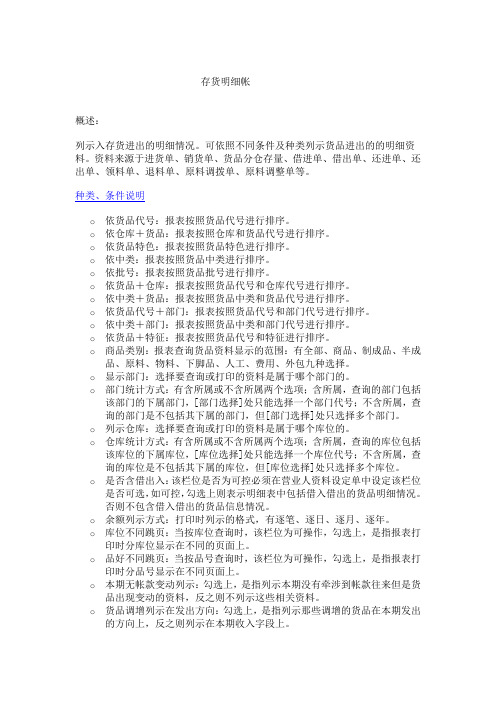
存货明细帐概述:列示入存货进出的明细情况。
可依照不同条件及种类列示货品进出的的明细资料。
资料来源于进货单、销货单、货品分仓存量、借进单、借出单、还进单、还出单、领料单、退料单、原料调拨单、原料调整单等。
种类、条件说明o依货品代号:报表按照货品代号进行排序。
o依仓库+货品:报表按照仓库和货品代号进行排序。
o依货品特色:报表按照货品特色进行排序。
o依中类:报表按照货品中类进行排序。
o依批号:报表按照货品批号进行排序。
o依货品+仓库:报表按照货品代号和仓库代号进行排序。
o依中类+货品:报表按照货品中类和货品代号进行排序。
o依货品代号+部门:报表按照货品代号和部门代号进行排序。
o依中类+部门:报表按照货品中类和部门代号进行排序。
o依货品+特征:报表按照货品代号和特征进行排序。
o商品类别:报表查询货品资料显示的范围:有全部、商品、制成品、半成品、原料、物料、下脚品、人工、费用、外包九种选择。
o显示部门:选择要查询或打印的资料是属于哪个部门的。
o部门统计方式:有含所属或不含所属两个选项;含所属,查询的部门包括该部门的下属部门,[部门选择]处只能选择一个部门代号;不含所属,查询的部门是不包括其下属的部门,但[部门选择]处只选择多个部门。
o列示仓库:选择要查询或打印的资料是属于哪个库位的。
o仓库统计方式:有含所属或不含所属两个选项;含所属,查询的库位包括该库位的下属库位,[库位选择]处只能选择一个库位代号;不含所属,查询的库位是不包括其下属的库位,但[库位选择]处只选择多个库位。
o是否含借出入:该栏位是否为可控必须在营业人资料设定单中设定该栏位是否可选,如可控,勾选上则表示明细表中包括借入借出的货品明细情况。
否则不包含借入借出的货品信息情况。
o余额列示方式:打印时列示的格式,有逐笔、逐日、逐月、逐年。
o库位不同跳页:当按库位查询时,该栏位为可操作,勾选上,是指报表打印时分库位显示在不同的页面上。
o品好不同跳页:当按品号查询时,该栏位为可操作,勾选上,是指报表打印时分品号显示在不同页面上。
原料耗用计算公式
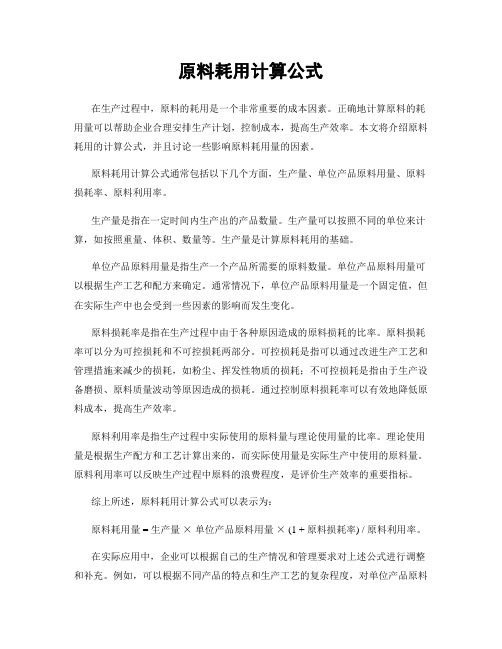
原料耗用计算公式在生产过程中,原料的耗用是一个非常重要的成本因素。
正确地计算原料的耗用量可以帮助企业合理安排生产计划,控制成本,提高生产效率。
本文将介绍原料耗用的计算公式,并且讨论一些影响原料耗用量的因素。
原料耗用计算公式通常包括以下几个方面,生产量、单位产品原料用量、原料损耗率、原料利用率。
生产量是指在一定时间内生产出的产品数量。
生产量可以按照不同的单位来计算,如按照重量、体积、数量等。
生产量是计算原料耗用的基础。
单位产品原料用量是指生产一个产品所需要的原料数量。
单位产品原料用量可以根据生产工艺和配方来确定。
通常情况下,单位产品原料用量是一个固定值,但在实际生产中也会受到一些因素的影响而发生变化。
原料损耗率是指在生产过程中由于各种原因造成的原料损耗的比率。
原料损耗率可以分为可控损耗和不可控损耗两部分。
可控损耗是指可以通过改进生产工艺和管理措施来减少的损耗,如粉尘、挥发性物质的损耗;不可控损耗是指由于生产设备磨损、原料质量波动等原因造成的损耗。
通过控制原料损耗率可以有效地降低原料成本,提高生产效率。
原料利用率是指生产过程中实际使用的原料量与理论使用量的比率。
理论使用量是根据生产配方和工艺计算出来的,而实际使用量是实际生产中使用的原料量。
原料利用率可以反映生产过程中原料的浪费程度,是评价生产效率的重要指标。
综上所述,原料耗用计算公式可以表示为:原料耗用量 = 生产量×单位产品原料用量× (1 + 原料损耗率) / 原料利用率。
在实际应用中,企业可以根据自己的生产情况和管理要求对上述公式进行调整和补充。
例如,可以根据不同产品的特点和生产工艺的复杂程度,对单位产品原料用量进行细化和精确计算;可以根据生产设备的磨损情况和原料质量的波动,对原料损耗率进行动态调整;可以根据生产计划和市场需求,对原料利用率进行灵活控制。
除了上述因素之外,原料的存储和运输也会对原料耗用产生影响。
不良的存储条件和不当的运输方式都会导致原料的损耗和浪费。
合同耗用材料统计表模板
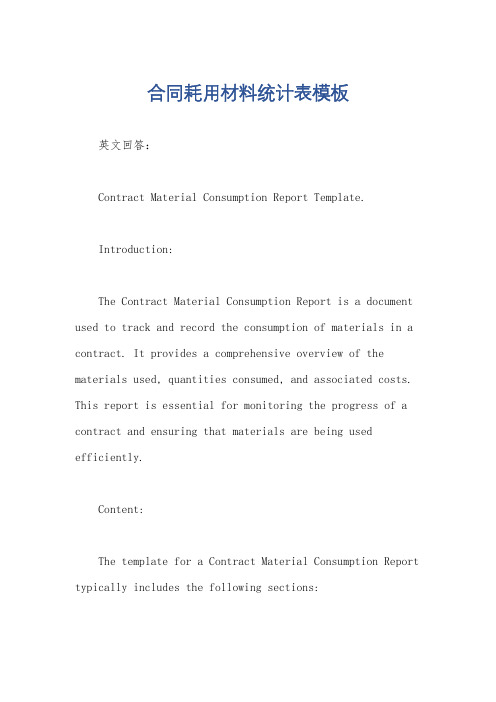
合同耗用材料统计表模板英文回答:Contract Material Consumption Report Template.Introduction:The Contract Material Consumption Report is a document used to track and record the consumption of materials in a contract. It provides a comprehensive overview of the materials used, quantities consumed, and associated costs. This report is essential for monitoring the progress of a contract and ensuring that materials are being used efficiently.Content:The template for a Contract Material Consumption Report typically includes the following sections:1. Contract Details: This section includes information about the contract, such as the contract number, project name, and contract period. It provides a brief overview of the contract's scope and objectives.2. Material Details: This section lists all the materials that are being used in the contract. It includes the material name, code, unit of measurement, and cost per unit. Additionally, it may include information about the supplier or vendor from whom the materials are being procured.3. Consumption Details: This section records the quantity of materials consumed during a specific period. It includes the date of consumption, quantity consumed, and the corresponding cost. This information helps in tracking the material usage and identifying any discrepancies or inefficiencies.4. Cost Analysis: This section provides a summary of the total cost incurred for each material. It includes the total quantity consumed, unit cost, and the total cost.This analysis helps in evaluating the overall expenditureon materials and identifying opportunities for cost savings.5. Remarks: This section allows for any additional comments or observations related to the material consumption. It can be used to highlight any issues or challenges faced during the contract period or suggest improvements for future contracts.Example:To illustrate the usage of the Contract Material Consumption Report, let's consider a construction project. The contract involves building a commercial complex, and various materials such as cement, steel, bricks, and electrical fittings are required.In the Material Details section, the report will list these materials along with their respective codes, units of measurement (e.g., bags, tons, pieces, etc.), and costs per unit. For instance, cement may be listed as Material Code: CMT001, Unit: Bags, and Cost per Bag: $10.In the Consumption Details section, the report will record the quantity of each material consumed during a specific period. For example, if 100 bags of cement were used on a particular day, the report will include the date, quantity consumed (100 bags), and the corresponding cost ($1000).The Cost Analysis section will summarize the total cost incurred for each material. It will calculate the total quantity consumed (e.g., 500 bags of cement), multiply itby the unit cost ($10 per bag), and provide the total cost ($5000). This analysis will help in evaluating the overall expenditure on materials and identifying any cost variances.The Remarks section can be used to note any issues or observations related to material consumption. For instance, if there were delays in material delivery or if there were instances of material wastage, it can be mentioned here.中文回答:合同耗用材料统计表模板。
合同耗用材料统计表模板
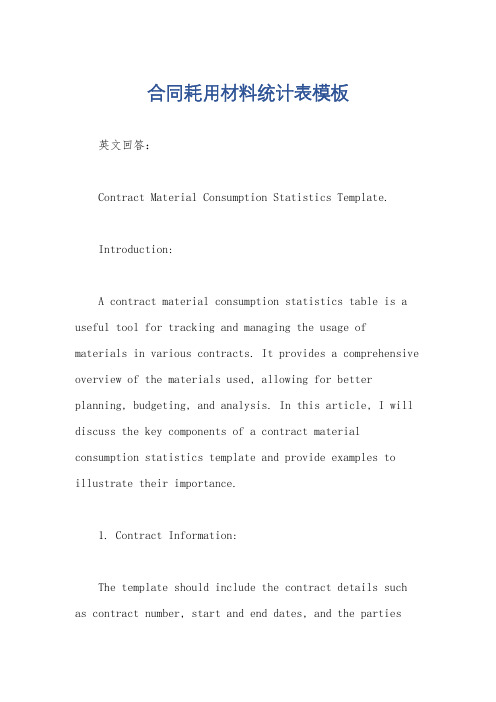
合同耗用材料统计表模板英文回答:Contract Material Consumption Statistics Template.Introduction:A contract material consumption statistics table is a useful tool for tracking and managing the usage of materials in various contracts. It provides a comprehensive overview of the materials used, allowing for better planning, budgeting, and analysis. In this article, I will discuss the key components of a contract material consumption statistics template and provide examples to illustrate their importance.1. Contract Information:The template should include the contract details such as contract number, start and end dates, and the partiesinvolved. This information helps in identifying which contract the materials are associated with and provides a reference for future analysis.Example: Let's say I am working on a construction project and have multiple contracts with different suppliers. The template will have separate sections for each contract, clearly indicating the contract number,start and end dates, and the names of the suppliers.2. Material Details:The template should have a section to record thedetails of the materials used, including the material name, quantity, unit of measurement, and cost. This information helps in understanding the consumption patterns and cost implications of different materials.Example: If I am managing a manufacturing contract, the template will have columns to enter the names of the materials used, such as steel, plastic, or rubber. I can then record the quantity of each material used in thecorresponding column and calculate the total cost based on the unit cost provided.3. Consumption Analysis:The template should include a section for analyzing the material consumption. This can be done by calculating the total quantity and cost of materials used for each contract, as well as the average consumption per unit or time period.Example: Let's say I have a contract for supplyingoffice stationery. The template will calculate the total quantity and cost of materials used, such as pens, papers, and staplers. It will also provide the average consumption per employee per month, allowing me to identify any excessive or insufficient usage.4. Variance Analysis:The template should include a section for variance analysis, comparing the actual material consumption withthe planned or budgeted consumption. This helps inidentifying any deviations and taking appropriate actions to control costs or improve efficiency.Example: If I have a contract for providing IT equipment, the template will compare the actual quantity and cost of materials used with the planned quantities and costs. If there is a significant variance, it may indicate issues such as overstocking or underutilization of resources, prompting me to investigate and make necessary adjustments.中文回答:合同耗用材料统计表模板。
经理会议建议的分析
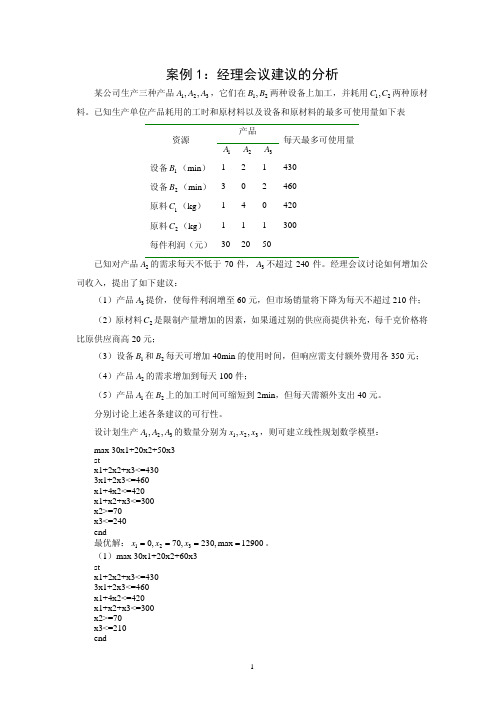
案例1:经理会议建议的分析某公司生产三种产品,它们在两种设备上加工,并耗用两种原材料。
已知生产单位产品耗用的工时和原材料以及设备和原材料的最多可使用量如下表321,,A A A 21,B B 21,C C 产品资源 1A 2A 3A 每天最多可使用量设备(min )1B 1 2 1 430 设备(min )2B 3 0 2 460 原料(kg )1C 1 4 0 420 原料(kg )2C 1 1 1 300 每件利润(元)302050已知对产品的需求每天不低于70件,不超过240件。
经理会议讨论如何增加公司收入,提出了如下建议:2A 3A (1)产品提价,使每件利润增至60元,但市场销量将下降为每天不超过210件;3A (2)原材料是限制产量增加的因素,如果通过别的供应商提供补充,每千克价格将比原供应商高20元;2C (3)设备和每天可增加40min 的使用时间,但响应需支付额外费用各350元;1B 2B (4)产品的需求增加到每天100件;2A (5)产品在上的加工时间可缩短到2min ,但每天需额外支出40元。
1A 2B 分别讨论上述各条建议的可行性。
设计划生产的数量分别为,则可建立线性规划数学模型: 321,,A A A 321,,x x x max 30x1+20x2+50x3stx1+2x2+x3<=4303x1+2x3<=460x1+4x2<=420x1+x2+x3<=300x2>=70x3<=240end最优解:。
12900max ,230,70,0321====x x x (1)max 30x1+20x2+60x3stx1+2x2+x3<=4303x1+2x3<=460x1+4x2<=420x1+x2+x3<=300x2>=70x3<=210end最优解:1290014533max ,210,3230,340321>====x x x 。
原料进料过程pfmea分析表

过程潜在失效模式及后果分析(PFMEA)
过程责任:质量部 关键日期:
PFMEA日期(编制): 修订:
PFMEA编号: 共1页,第 1 页
工序功能/ 潜在的失 潜在的失效
要求
效模式
后果
钢材类 (矽钢片 、冷板)
钢材类来 料错误
钢材类来 错,导致不 能成形
材质(软 料、硬 料)
1. 登记并控制发 放利器 2. 对利器的领用 、发放/回收作记 录 3. 管理人员巡查 是否有落实 4.虫鼠等防治控制 记录
6
2
2 24
4.采购合同
尺寸 /大
小(依照进 料检验指 导书/物料 承认书/图 纸/BOM
板材长/宽 或长或 短,厚度 或厚或薄
影响下料或 成型,甚至 损伤模具
表)
1.BOM未注明
6
2.采购未在采购 订货单上注明相
关要求
3
1.BOM分发到 位 2. 订货单注明 相关要求
1.IQC来料检查 2.工艺控制 3.首件检查
材质来料 错误
无法成型或 拉深爆裂或 冲凸点等
严 重 度 (S)
潜在的失效起因/ 机理
频 度 (O)
现行过程控制 预防
现行过程探测
探 测 度 (D)
1.BOM未注明
6
2.采购未在采购 订货单上注明相
关要求
4
1.BOM分发到 位 2. 订货单注明 相关要求
1.厂商物料标 识卡上标识 2.IQC检验标识
3
1.BOM未注明
5
2.采购未在采购 订货单上注明相
关要求
3
1.BOM分发到 位 2. 订货单注明 相关要求
材料费用的核算成本会计计算分析题

第三章:材料费用的核算资料1:某企业生产甲、乙两种产品,共同耗用某种原材料费用8 400元。
单件产品原材料消耗定额:甲产品15千克,乙产品12千克。
产量:甲产品100件,乙产品50件。
要求:按原材料定额消耗量比例分配并计算甲、乙产品实际耗用原材料费用。
资料2:甲、乙两种产品共同耗用101号和102号两种原材料。
甲产品投产100件,原材料单件消耗定额为:101号4千克,102号5千克。
乙产品投产200件,原材料单件消耗定额为:101号5千克,102号7.5千克。
甲、乙两种产品实际消耗总量为:101号2800千克,102号2000千克。
原材料计划单价为:101号2元,102号3元。
原材料价格差异(成本差异)率为—2%。
要求:根据定额消耗量比例法分配甲、乙两种产品的原材料费用。
资料3:某基本生产车间生产A、B两种产品,根据领料单凭证归类汇总后,编制下列原材料耗用表:要求:编制原材料费用分配表;计算A、B产品原材料实际费用;并作相应的会计分录。
资料4:某企业有一个基本生产车间,生产A、B两种产品;两个辅助车间即机修车间和供水车间,为基本生产车间和管理部门提供服务。
某日A产品产量为80件:B产品产量为100件,根据领料单汇总各单位领料情况如下表所示:该企业日常收发采用成本核算;A、B两产品共同耗用的材料按产量比例分配。
要求:根据上述资料编制材料费用分配表;并作有关的会计分录。
第四章:人工费用的核算资料1某企业发生下列经济业务:(1)企业向银行提取现金10000元准备发放工资。
(2)支付工资10000元。
(3)李华因出差未领工资240元,月末及时交财务会计部门。
(4)分配应支付的职工工资10000元,其中生产工人的工资6000元,车间管理人员工资2000元,行政管理人员工资1000元,医务、福利部门人员工资1000元。
要求:对每项也去分别编制会计分录。
资料2:某企业根据某月份工资结算凭证汇总的工资费用为:基本生产车间甲、乙两种产品,生产工人的计时工资共计39200元,管理人员工资2840元。
产品成本分析图
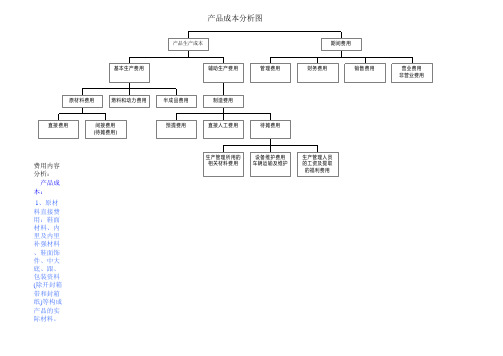
产品成本分析图产品成本:1、原材料直接费用:鞋面材料、内里及内里补强材料、鞋面饰件、中大底、跟、包装资料(除开封箱带和封箱纸)等构成产品的实际材料。
2、原材料待摊费用:胶水、封箱带、封箱纸、胶水刷、美纹纸、塑胶垫板、油漆、去渍油、慢干水等低值易耗品和通用材料。
3、燃料和动力:供水电设备、生产线机械设备、高值的生产器具和供电设备耗用的燃料等。
4、半成品费用:外发加工费用、原材料腹膜、跟底组合等费用。
5、预提费用:部份供应商的定金预支及其它与产品有关的预支费用。
6、直接人工费用:直接参与产品生产劳动的员工工资。
7、生产管理的材料费用:所有管理生产资料所用到的文件夹之类的办公用品和生产中使用的相关表单的成本费用。
8、设备维护费及车辆费用:机器零件的更换(以旧换新),机器设备的维修、安装和保养费,以及车辆运输和保养费。
9、生产管理人员的工资费用:除开财务部、人事、总务、外贸部之外,公司所有与产品生产有直接关系的计时人员的工资及所提取的福利费用。
期间费用:1、管理费用:用于购置和建造固定资产的费用;人事、行政、外贸及总经理的工资、福利和其它耗用(如公司清洁费、组织企业文化、加工会等相关经费)。
2、财务费用:企业的某项投资决策的费用支出和其它与产品无关的财务经费。
3、销售费用:产品完工后,在销售过程中发生的费用,如商检、报关、空运或汽运等相关费用。
4、营业费用:耗费和营业收入之间有一定的因果关系的费用。
如为了扩大产品市场,公司业务经理或总经理与客户之间发生的与产品佣金无关的费用。
(如待客餐费、差旅费等)5、非营业费用:与产品无关的某项投资亏损的费用,即非营业费用。
餐费、差旅费等)。
